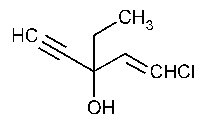Ethchlorvynol
1-Penten-4-yn-3-ol,1-chloro-3-ethyl-.
1-Chloro-3-ethyl-1-penten-4-yn-3-ol [113-18-8].
»Ethchlorvynol contains not less than 98.0percent and not more than 100.0percent of E-ethchlorvynol (C7H9ClO),calculated on the anhydrous basis.
Packaging and storage—
Preserve in tight,light-resistant glass or polyethylene containers,using polyethylene-lined closures.
Identification—
A:
Infrared Absorption á197Fñ.
B:
Dissolve about 1g in 20mLof methanol.To 1mLof the solution,add about 4drops of 6Nammonium hydroxide,mix,then add silver nitrate TS,a few drops at a time:a yellowish white precipitate is formed,and it at first redissolves,but becomes insoluble when an excess of silver nitrate TShas been added.
C:
To 10mLof the solution prepared in Identificationtest Badd 5mLof freshly prepared m-phenylenediamine hydrochloride-oxalic acid solution (prepared by dissolving 1g of m-phenylenediamine hydrochloride and 1g of oxalic acid in 35mLof water and filtering,if necessary):a reddish orange color is produced in about 3minutes.
Refractive index á831ñ:
between 1.476and 1.480.
Acidity—
Dissolve 5.0mLof Ethchlorvynol in 50mLof a mixture of equal volumes of water and methanol that has been neutralized to the phenolphthalein endpoint with 0.1Nsodium hydroxide.Add 1mLof phenolphthalein TS,and titrate with 0.10Nsodium hydroxide to a pink endpoint:not more than 1.7mLof 0.10Nsodium hydroxide is required for neutralization.
Water,Method Iá921ñ:
not more than 0.2%.
Chromatographic purity—
Calculate the percentage of each peak,other than the E-ethchlorvynol peak,observed in the chromatogram of the Ethchlorvynol obtained as directed in the Assaytaken by the same formula:
100ri/rt,
in which riis the response of each secondary peak and rtis the sum of all of the peaks observed in the chromatogram:not more than 0.2%of toluene,not more than 1.5%of Z-ethchlorvynol,and not more than 0.3%of any other impurity is found,and the total of all observed impurities is not more than 2.0%.
Assay—
Resolution solution—
Add 2.5µLof toluene to 0.5mLof USP Ethchlorvynol RS,and mix.
Chromatographic system
(see Chromatography á621ñ)—The gas chromatograph is equipped with a thermal conductivity detector and a 1.8-m ×4-mm glass column (pretreated with 10%dimethyldichlorosilane in toluene)packed with 10%phase G16on 60-to 80-mesh support S1AB.The column is maintained at about 160 ,and the injector and the detector are maintained at about 200
,and the injector and the detector are maintained at about 200 .The carrier gas is dry helium,flowing at a rate of about 30mLper minute.Chromatograph the Resolution solution,and record the peak responses as directed for Procedure:the relative retention times for toluene,b-chlorovinylethyl ketone (if present),Z-ethchlorvynol,and E-ethchlorvynol are about 0.1,0.2,0.8,and 1.0,respectively;the resolution,R,between the Z-and E-ethchlorvynol peaks is not less than 1.0;and the relative standard deviation for replicate injections is not more than 2.0%.
.The carrier gas is dry helium,flowing at a rate of about 30mLper minute.Chromatograph the Resolution solution,and record the peak responses as directed for Procedure:the relative retention times for toluene,b-chlorovinylethyl ketone (if present),Z-ethchlorvynol,and E-ethchlorvynol are about 0.1,0.2,0.8,and 1.0,respectively;the resolution,R,between the Z-and E-ethchlorvynol peaks is not less than 1.0;and the relative standard deviation for replicate injections is not more than 2.0%.
Procedure—
[NOTE—Use peak areas where peak responses are indicated.]Inject about 3µLof Ethchlorvynol into the chromatograph,record the chromatogram,and measure the responses for all of the peaks.Calculate the percentage of E-ethchlorvynol (C7H9ClO)in the specimen of Ethchlorvynol taken by the formula:
100re/rt,
in which reis the response of the E-ethchlorvynol peak obtained in the chromatogram of the Ethchlorvynol and rtis the sum of the responses of all of the peaks observed in the chromatogram.
Auxiliary Information—
Staff Liaison:Salvador C.Salado,M.S.,Scientist and Latin American Liaison
Expert Committee:(PA3)Pharmaceutical Analysis 3
USP28–NF23Page 787
Phone Number:1-301-816-8165
